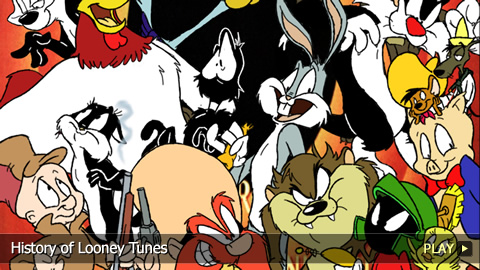History of Looney Tunes

These cartoons may be the product of another era, but they continue to entertain countless generations with their hysterical antics. Welcome to WatchMojo.com and today we’ll be taking a look back at the history of Looney Tunes.
This legendary series and its wide collection of eccentric characters have been amusing audiences since April 19th, 1930. That day marked the debut of Warner’s theatrical cartoon short “Sinkin’ in the Bathtub.”
This black and white comedy was centered on the character Bosko the “Talk-Ink Kid,” and he was Looney Tunes’ first main character. He was aptly nicknamed for his starring role in the first animated cartoon that featured a pre-recorded soundtrack that was not released by Disney, and that feature came complete with synchronized speech and dancing.
Unfortunately, this cartoon also marked the beginning of Looney Tunes’ use of ethnic and racial stereotypes in its animations.
By 1933, Bosko and his friends were no longer part of the Looney Tunes family due to a copyright dispute. This pivotal event led to the introduction of new characters, including the series’ first major star: Porky Pig. Porky made his debut in Warner’s 1935 Merrie Melodies cartoon “I Haven’t Got a Hat.”
Within a few years, Looney Tunes introduced its signature theme “The Merry-Go-Round Broke Down,” and Porky Pig’s signature phrase. Of course, Porky couldn’t carry the entire series by himself. He was joined by dozens of other creations like Daffy Duck and – of course – Bugs Bunny. Bugs made his official debut as a cast member in 1944 in the Looney Tunes short “Buckaroo Bugs.”
While Warner was caught in a bitter rivalry with Disney, the production house made several technical advancements in the years that followed. One such innovation was the incorporation of color in 1942 with the short “The Hep Cat.”
By the 1950s, the shorts transitioned to syndicated television. However, they were heavily edited to remove scenes of dramatic violence, alcohol, smoking and racial caricatures to make them safe for children of all ages. From 1960 onward, Looney Tunes appeared in the anthology compilation “The Bugs Bunny Show,” which was later renamed “The Bugs Bunny and Tweety Show.”
Meanwhile, the theatrical shorts faded away, before they eventually made sporadic returns to promote unrelated feature films created by the company.
Looney Tunes characters finally shared the screen with their longtime Disney rivals in the 1988 Oscar-winning live action/animation hybrid “Who Framed Roger Rabbit?” Their feature film efforts continued with the Michael Jordan-led sports film “Space Jam” and “Looney Tunes: Back in Action.”
While you can still find the original cartoons airing on television today, Looney Tunes has undergone many changes since it first debuted. For example, the series adopted the use of computer animation, bright colors and all-new songs. These tweaks helped it appeal to younger generations, as evidenced by 2011’s “The Looney Tunes Show.”
Since its debut in 1930, Warner Bros.’ beloved animated series has transitioned from cartoon shorts on the silver screen to full-length film, television series and even video games. Looney Tunes has earned several Academy Awards, been inducted into the National Film Registry and because of this it remains an unshakeable mainstay of popular culture.
Sign in
to access this feature